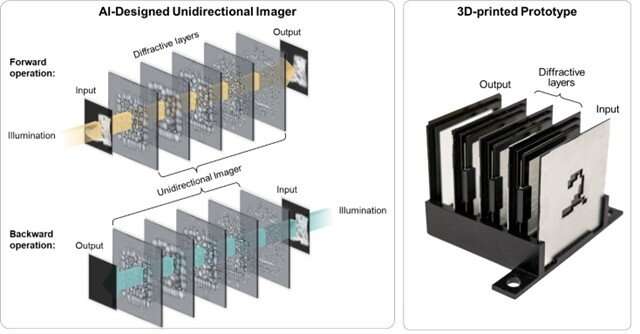Researchers at the UCLA Samueli School of Engineering have developed a new unidirectional material to challenge the traditional paradigm in optical imaging.

Optical systems made up of lenses, commonly used for imaging and communication, work bidirectionally like a pipe that allows two-way liquid flow. This is possible because standard optical materials and lenses permit light to travel in both directions through devices like cameras.
Researchers at the UCLA Samueli School of Engineering have created a novel unidirectional material to challenge the conventional paradigm in optical imaging. The researchers used artificial intelligence (AI) to develop materials with sub-wavelength structural details. As a result, they have designed an imager that only allows imaging in one direction while effectively blocking the other direction.
Using AI-driven engineering, multiple structured, transparent layers modulate optical waves asymmetrically in forward and backward directions. This results in a unidirectional imager that only forms images from the input to the output field of view, blocking the reverse path. The unidirectional imager is functional under broadband light despite being trained with only one wavelength, and it works with any orientation of light oscillations and is unaffected by light polarization. In experiments, the researchers used terahertz radiation to demonstrate the effectiveness of the design on a 3D-printed multilayered imager.
The team also created a second imager that lets the user decide which direction the image is blocked by selecting a particular wavelength. Images can only form from left to right at one wavelength, while at a different wavelength, the reverse direction is the only way to view the image. The wavelength-multiplexed design improves the flexibility and functionality of the unidirectional imager, turning it into a switchboard that manages the transmission of information carried by light waves.
Unidirectional imagers are thin, with a thickness of just a few tens of wavelengths in the visible spectrum, equivalent to a stamp’s thickness. They can function at any point on the electromagnetic spectrum, using various transmissive materials or substrates. The impact of these unidirectional imagers could be substantial in several fields, such as telecommunications, defense, and security.
Reference : Jingxi Li et al, Unidirectional imaging using deep learning–designed materials, Science Advances (2023). DOI: 10.1126/sciadv.adg1505






